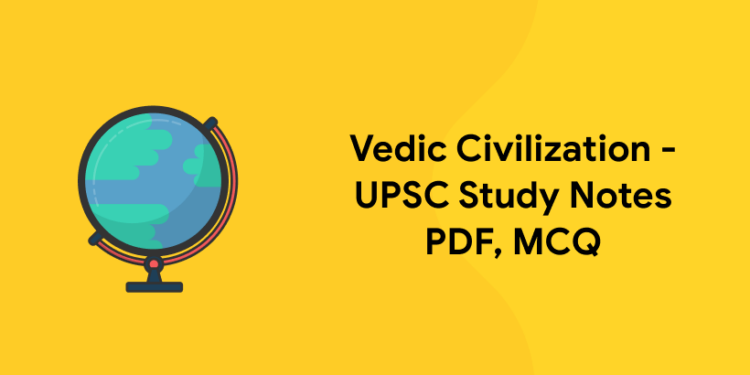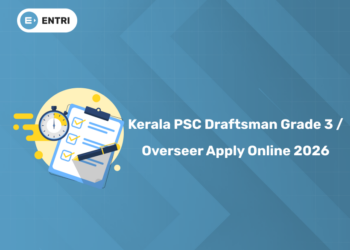Table of Contents
The Vedic Age is the most essential part of the History of Ancient India. Those candidates who are preparing for any of the competitive exams should have a thorough understanding of the Vedic age. It is important to learn about the Vedic period in detail for the UPSC and other exams that are conducted frequently by the governmental and the non-governmental agencies. The aspirants can expect questions both from the Vedic period for the upcoming UPSC Prelims and Mains exam alike. This is an important topic that the candidates must cover if they wish to crack the exam effectively and fruitfully. From the point of view of the UPSC exam, this article will discuss and cover all the essential articles related to Vedic Civilization.
The Vedic Civilization
The Vedic Civilization spans between c. 1500 – 500 BCE. Followed by the Harappan civilization, a great civilization that has brought changes to the lives of the entire human beings happened. It is none other than the Vedic Culture. The Vedic culture and civilization can be regarded as the epitome of the civilization which called for a drastic change in human culture. The Vedic manuscripts are the immediate births of the reconstruction of the Vedic Civilization. Even though not entirely, Archeological materials also have supported the augmentation of the texts. Vedic texts are acknowledged to be penned by the Indo-Aryans.
The orators of a subgroup of the Indo-Iranian annex of the Indo-European lineage of tongues are referred to as Indo-Aryans. Composers of Rig Veda composers represent them as Arya. The term Arya is terminology derived from the combination of the words “Ar” which means to cultivate. This is also bearing another meaning which can be used to denote the kin or comrade. The word had yet another meaning in Sanskrit, which is used to denote the newcomers or can also be called the people from the noble family.
Theories on Vedic Civilization
1: Which one of the following is not a Harappan site?
Many of the theories are associated with the birth of the Vedic Civilization and Aryans. Their migration, settlement, and invasion in the subcontinent of India need to be learned to get a proper understanding of the same. The Central Asian Theory is the most important among them which was propagated by a German scholar of comparative languages named Prof. Max Muller. As per the Central Asian Theory, the Aryan race initially haled in Central Asia. The comparative study of the “Avesta” and Vedas proves that there is not only the words but also the concept relationship existing between them. The European theory was proposed by Sir William Jones, Morgan, Giles, and Shroeder. As per the proposed theory, Aryans were descendants of Europe. They claimed that the Aryan race inhabited the places in Europe and later voyaged to the places in India.The disciples of this hypothesis confirmed the similitude of Sanskrit with the European vocabularies.
Bal Gangadhar Tilak, who has propagated the theory of North Pole/Arctic theory claimed that the Aryans originated in the Northern Arctic region. He remarked that the Rig Veda incorporates explicit connections to a zone where extreme chilliness and extended daytimes and gloamings of six months are estimated. Swami Dayanand Saraswati propagated the Tibet theory according to which Tibet is the origin place of the Aryans. The Indian theory was propagated by Sri D.S Trivedi Ganga Nath Jha, Dr. A.C Dass, and Sri L.D Kalla. Aryans were the denizens of the Sapta Sindhu according to this theory. The sacrificial ceremonies of the Vedic Aryans suggest their Indian heritage.
The river accolades in the Rig Veda cite the expressions of the rivers of this province. The Himalayan region has a close resemblance through the mentioning of the flora and fauna. As we consider the language, the Vedic language is in close connection with the Indian Languages. Some Aweren immigrants came to the Indian Subcontinents as the immigrants of the region. They covered Punjab and Western Uttar Pradesh, Eastern Afghanistan. The Rig Veda mentions the river Indus (Sindhus) and its five tributaries. The five tributaries are the Ravi (Parushni), Satluj (Sutudri)Jhelum (Vitasta), Beas (Vipasa), and Chenab (Askini). the settlement of the Aryans in India is called the Seven Rivers.
The Early Vedic or The Rigvedic Civilization
Early Vedic or The Rigvedic Civilisation ranges between c. 1500 – 1000 BCE. The Early Vedic Literature retains the Rig Veda Samhita and a group of texts which can be called the family books as they are believed to be composed by the families of clairvoyant lyricists like Vishvamitra, Gritsamada, Atri, Vasishtha, Bharadvaja.
Later Vedic Literature emerged in the year c. 1000 – 500 BCE which includes the1, 8, 9, & 10 books of the Rig Veda Samhita, the Samhitas of the Yajur, and the Atharva Vedas Sama Veda, and the Aranyakas, Brahmanas & Upanishads affixed to the 4 Vedas.
Vedic Literature
Vedic literature is a considerable powerful seed of knowledge concerning the Vedic civilization. The phrase “Veda” implies wisdom. Vedic literature has developed the period over multiple centuries and lived passed down by word of mouth from era to era. At a later point in time, compilation happened and it is called compiled and written down and is considered the most premature surviving manuscript from the 11th century.There are 4 Vedas in Vedic culture namely Rig Veda, Sama Veda, Yajur Veda, and Atharva Veda and the Vedas are having four parts in general. They are the Brahmana, Aranyaka, Samhita, and Upanishads.
Rig Veda
It is the most geriatric Veda and illustrates the life of early Vedic individuals in India. It is the Rig Veda is the literature forecasting World Human Heritage according to UNESCO. It consists of 1028 accolades (Sukta) which are further divided into ten Mandalas. The Upaveda of Rig Veda is called the Ayurveda. The oldest part of the Rig Veda is known as Mandalas 2 – 7 from Samhita. They are termed “family books”. The hymns dedicated to Gods can be seen in Mandala 8.
Sama Veda
The Sama Veda or the “Veda of Chants” is the assemblage of poems illustrated almost completely from the Rig Veda, that is equipped with melodic inscriptions and is planned as an asset to the implementation of holy harmonies. Sama Veda’s Upaveda is the Gandharva Veda.
Yajur Veda
Yajur Veda is all about the ritual knowledge and the wisdom associated with it. the procedures related to the sacrificial performances are the main theme of the Yajur Veda. The Yajur Veda is mainly divided into many branches mainlu Krishna Yajur Veda / Black Yajur Veda,Shukla Yajur Veda/ Vajasaneya / White Yajur Veda. The Dhanur Veda is the upaveda of Yajur Veda.
Atharva Veda
Atharva Veda is dependent upon the magic spells. The magic spells are used to ward off the evil power and the spirits of the danger. It is classified into books with 711 hymns. The upaveda of the Atharva Veda is Shilpa Veda.
Brahmanas
The Brahmanas include the meanings of the Vedic hymns. The application of the hymns, the correct way of pronunciation, and the stories associated with them are all included in the Brahmanas. The Veda cannot stand alone without a Brahmanas fastened to it. Kaushitaki Brahmanas were known for their connection with the Rig Veda. Sama Veda can be detailed byTandya and Jaiminiya Brahmanas . Yajur Veda can be detailed by Taittiriya and Shatpatha Brahmanas. Atharva Veda is used by Gopath Brahmana for describing.
Aranyakas
The Aranyakas are also known as the “forest books”. They were composed and edited by the hermits. They were residing in the forest. They gave more importance to meditation and sacrifices. They urged us to look at life and its way in a very philosophical way.
Upanishads
There are 108 Upanishads available and 13 of them are considered the most significant. The Upanishad is to “sit near someone”. The concepts of ‘Atman’ and ‘Brahman’ were introduced in Upanishads. It revolves around the concept of the core of an individual’s self residing in the soul. Neither the body nor the mind plays an essential role here. But the quintessential part is played by the soul.
Vedanta
The Vedanta demonstrates the definitive ambition of the Vedas and embodies the destiny of the Vedas. It reproaches renunciations, and traditions and indicates the last grade of the Vedic period.
Vedanga
The literal connotation of the phrase Vedanga is “limbs of the Vedas”. It resembles the stems of the body, they function corroborating and augmenting roles in the investigation, conservation, and saving of the Vedas and the Vedic traditions. They are deemed to be of mortal conception and are composed in the constitution of Sutras There are 6 Vedangas namely, Jyotisha (Astronomy), Nirukta (Etymology), Chhanda (Metrics), Kalpa (Ritualistic science)Vyakaran (grammar) and Shiksha (Phonetics).
Puranas
The phrase Purana signifies ‘ancient’ or ‘old’. Puranas are believed to be written by Ved Vyasa. The Puranas dine miscellaneous issues regarding spiritual blossoming that emerged almost the 5th and 6th centuries. The Puranas mirror the evolution of Hindu Dharma, the requirement of humankind in archaic duration, colonial traditions, spiritual traditions as well as yogic approaches to retribution.
Vedic Civilization- MCQ
Those candidates who are pre[ring for the UPSC exam should know about the Vedic Civilization. Regular revisiting on this topic can enrich the candidates to furnish the knowledge in a better way. The candidates can use the set of MCQs given below for a better and efficient more understanding of Vedic Civilization.
- The only Veda to have been rendered musically is
A. The Rig Veda
B. The Sama Veda
C. The Yajur Veda
D. The Atharva Veda
Answer: Option B
- From where the famous ‘Gayatri Mantra’ has been taken?
A.Yajur veda
B. Atharva Veda
C. Rig Veda
D. Sarna Veda
Answer: Option C
- ‘Ayurveda’ has its origin in
A.Rig Veda
B. Sama Veda
C. Yajur Veda
D. Atharva Veda
Answer: Option D
- In the early Vedic-period, Varna system was based on
A.Education
B. Birth
C. Occupation
D. Talent
Answer: Option C
- The ritualistic precepts pertaining to the hymns of the Vedas are known as the
A.Samhita
B. Aranyakas
C. Brahmanas
D. Upanishads
Answer: Option C
- The famous vedic saying “war begins in the minds of men” is contained in the
A.Mundakopanishad
B. Mahabharata
C. Rig Veda
D. Atharva Veda
Answer: Option C
- The crop which was not known to Vedic people is
A.Barley
B. Wheat
C. Rice
D. Tobacco
Answer: Option D
- The Veda which deals with the rituals is known as
A.Rig veda
B. Yajur veda
C. Sama veda
D. Atharva veda
Answer: Option B
- The name of the Indian Astronomer (who knew five astronomical systems), who lived in the 6th century was
A. Varahamihira
B. Bhandarkar
C. Pujyapada
D. Prasastapada
Answer: Option A
- Who among the following was the pioneer of Yoga?
A.Patanjali
B. Banabhatta
C. Atreya
D. Vrudukanta
Answer: Option A
- Which of the following Craftsmanship was not practised by the Aryans?
A.Pottery
B. Jewellery
C. Carpentry
D. Blacksmith
Answer: Option D
- Two popular Assemblies of the Vedic period were
A. Sabha and Mahasabha
B. Mahasabha and Ganasabha
C. Sabha and Samiti
D. Ur and Kula
Answer: Option C
- The Rigvedic Aryans were governed by a
A.Tribal republic
B. Form of democracy
C. Monarchical government
D. Rule by elders
Answer: Option C
- Who was the eldest brother among the Pandavas?
A.Yudhishthira
B. Bhima
C. Sahadeva
D. Nakula
Answer: Option A
- The philosophical essence, The world is but God manifest and God is my own soul may be traced to the
A.Vedas
B. Upanishadas
C. Puranas
D. Manusmriti
Answer: Option B
- Which one of the following Vedas contains sacrificial formula?
A.Sama Veda
B. Rig Veda
C. Yajur Veda
D. Atharva Veda
Answer: Option C
- Name the temple in Combodia where scenes from Ramayana and Mahabharatha are depicted
A.Borobudur
B. Kailashnath
C. Angkor Wat
D. Brihadeshwara
Answer: Option C
- The most important craftsman in the Vedic period was the
A.blacksmith
B. goldsmith
C. carpenter
D. barber
Answer: Option C
- Which of the following contains the famous Gayatrimantra?
A.Rigveda
B. Samaveda
C. Kathopanishad
D. Aitareya Brahmana
Answer: Option A
- The Sage who is said to have Aryanised South India, was
A. Yagnavalkya
B. Vashistha
C. Agastya
D. Vishwamitra
Answer: Option C
Grab the latest Kerala PSC study materials! Register here!
Vedic Civilization- PDF
The candidates can use the PDF format of the Vedic Civilization. The PDF can be saved for future use. Download the PDF directly using the given link and start the preparation at the earliest.
Click here to download the notes and pdf on Vedic Civilization!
The UPSC exam is around the corner. those candidates who wish to crack the exam within a limited period can use the materials available at Entri App for a better learning process. The candidates can use the question papers, MCQs, and Video- audio classes available at the Entri App to brace themselves to face the challenge wisely.











